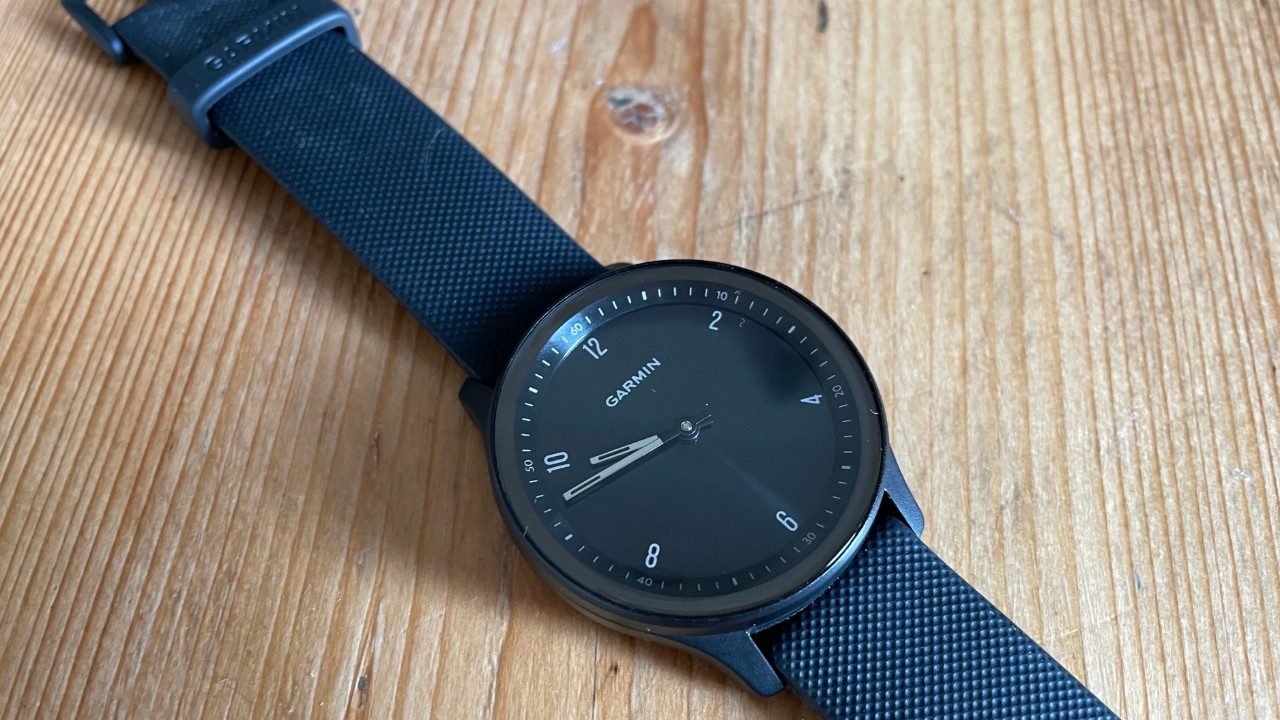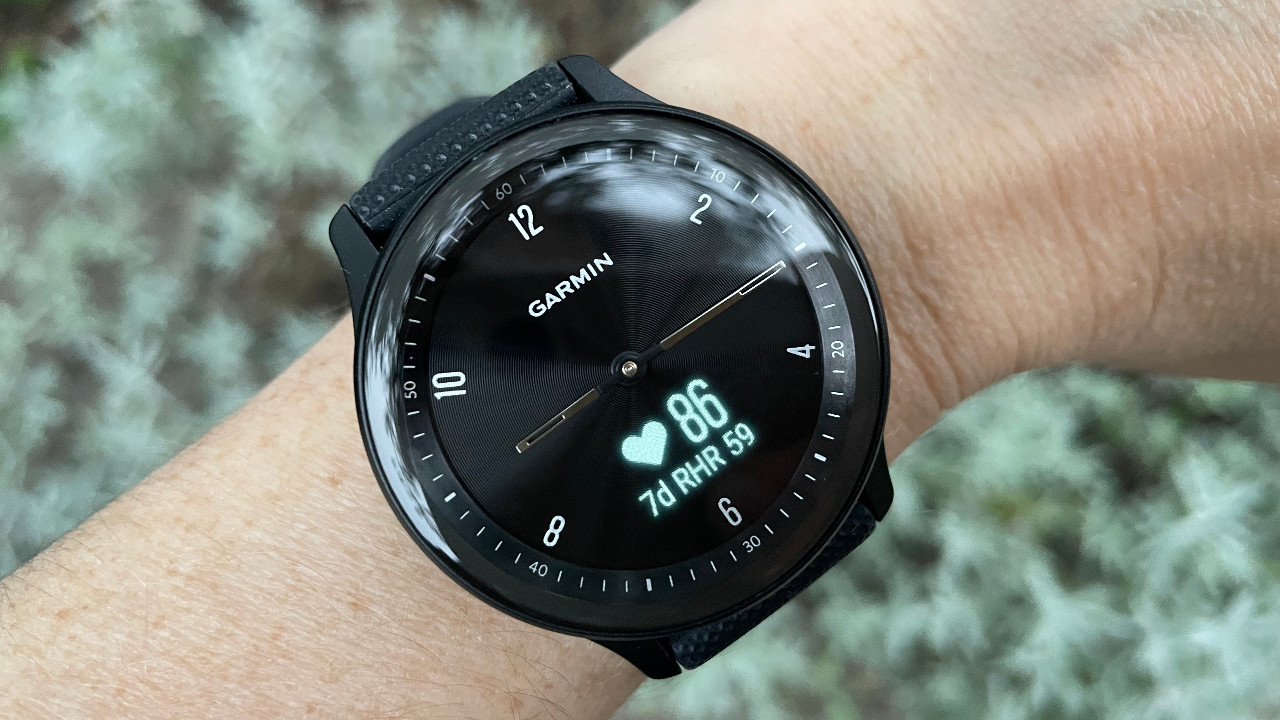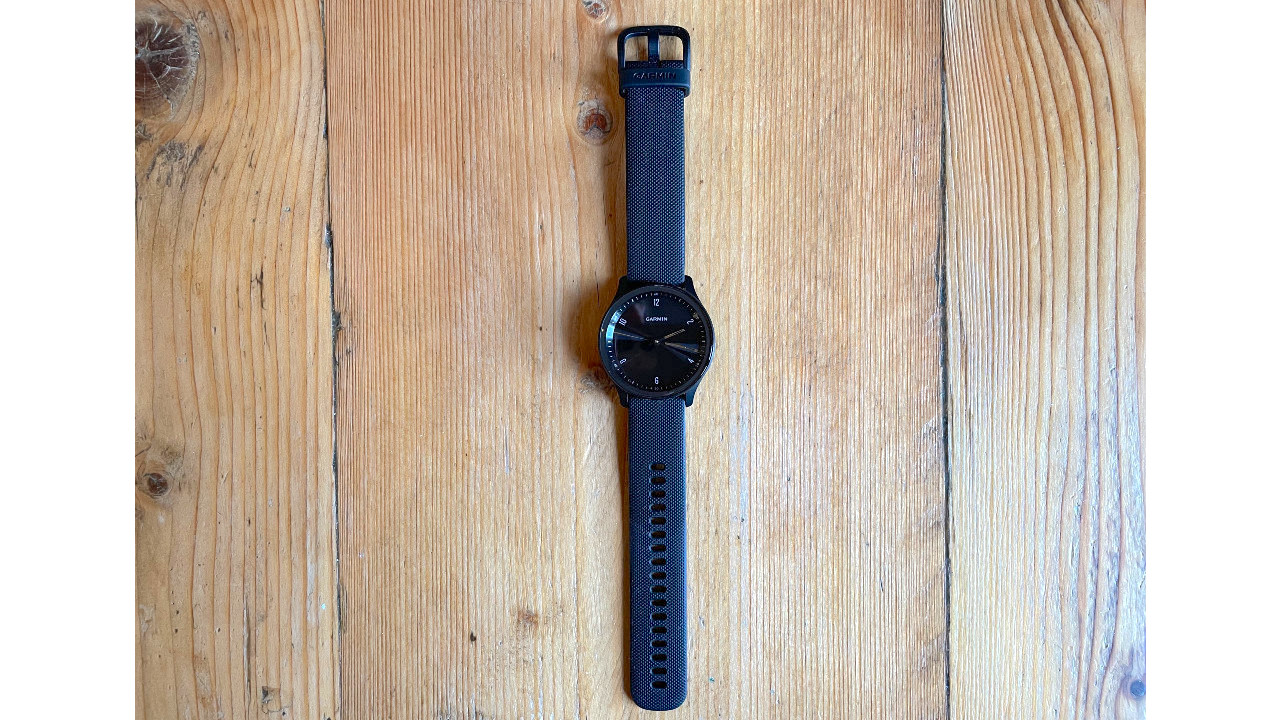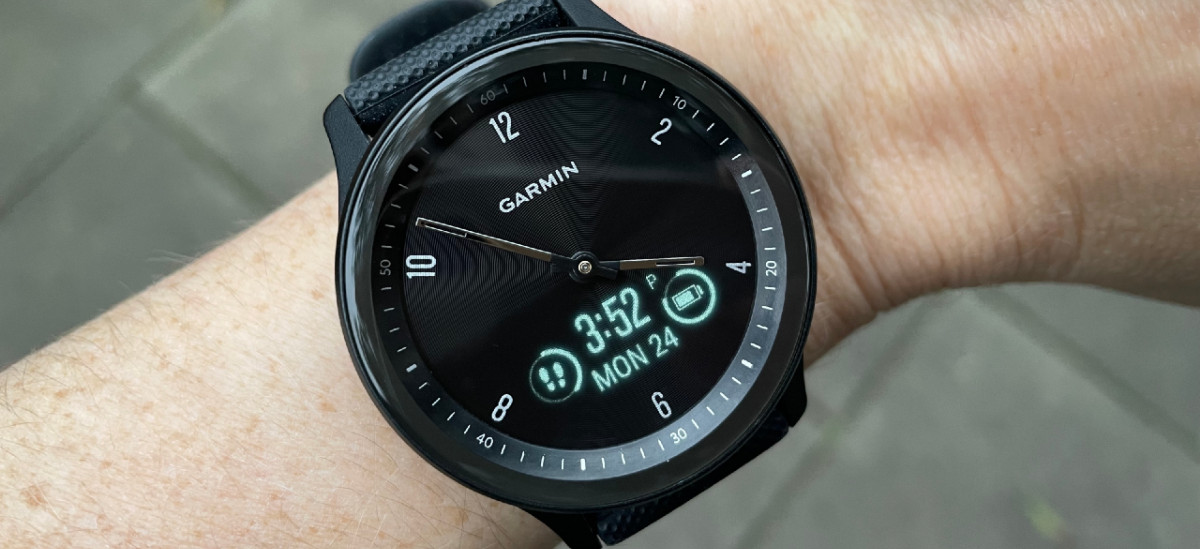Our Verdict
This hybrid smartwatch tracks your activity, and with its analogue face it’s a good choice for people who don’t want to look like they’re wearing a sports watch. However, with its lack of built-in GPS and small touchscreen controls, it’s not suited to serious exercisers.
For
- Stylish analogue looks
- Lightweight and comfortable
- Provides helpful snapshot of overall health
Against
- No on-board GPS
- Fiddly touchscreen controls
- Small screen is hard to read while exercising
- Screen not the sharpest
- Garmin app hard to navigate
You can trust Coach
At first glance, the Garmin Vivomove Sport appears to be a minimalist analogue watch, but it has a neat trick up its sleeve. When you raise your arm to wake the device, the watch hands sweep out of the way with a pleasing movement, revealing a previously camouflaged small screen on the lower half of the watch face.
The Vivomove Sport takes the features of the best fitness trackers and hides them in the guise of a watch, appealing to casual exercisers who want to be more aware of their overall health.
I’ve tested the Vivomove Sport over three months and during that time found it useful and unobtrusive. The watch relays notifications from your phone and displays health stats at a glance. It also provides sports and activity tracking, although it’s lacking some functions I like in a sports watch.
- NEWSFLASH: New Garmin Vivomove Trend (2nd February 2023)
Garmin Vivomove Sport Review: Price And Availability
The Garmin Vivomove Sport was released in January 2022 and costs £159.99.
The Vivomove Sport with its one screen is the most affordable option in the range, compared with £169.99 for the Vivomove 3, £259.99 for the Vivomove Style and £439.99-£479.99 for the Vivomove Luxe. While those names suggest you pay more for better-looking devices, it’s fairer to say the increase in cost comes down to more expensive materials. The Vivomove Sport may come with a silicone band, but it is available in three attractive colour combinations – cocoa with peach gold accents, ivory with peach gold accents and mint with silver accents – as well as all black.
Garmin Vivomove Sport Design

As with the other watches in Garmin’s Vivomove range, the Sport has analogue looks with “hidden” smartwatch and sports-tracking features. It’s the most affordable device in this range and, unlike the other options with their metal bezels and fancy straps, it’s not trying to compete with fashion watches. With its matt plastic bezel and textured silicone strap, it’s a semi-smart everyday watch with a slightly sporty look.
My first impression was of a good-looking watch, smaller and lighter than I expected. The face is sleek and elegant, while the bezel and strap hint at its sports-watch aspirations. On my small wrists the black model looks a touch oversized, but it is lightweight and comfortable to wear. I never felt it looked out of place, even when I was dressed for smarter occasions.
Navigating is all via the touchscreen: you swipe, tap and hold to scroll through the menus. I found the tapping and swiping, and the existence of two separate menus, fiddly. And all that swiping can make the small screen rather smeary – a screen that isn’t the sharpest to begin with.
From the main screen, you swipe to see your basic health data, including heart rate, step count, “intensity minutes” (any exercise that raises your heart rate) and breathing rate. It gives you Garmin’s nifty scores for your current stress levels and your “body battery”. The latter is derived from your health metrics combined and is represented by a number out of 100, which gives you an idea of how well rested you are in the morning, or how worn out you are at the end of the day. It’s simplistic, but I found it a good general indicator of when I needed extra rest.
In smartwatch mode the watch provides weather info, calendar events and all your phone’s notifications. And I do mean all of them: I wanted to opt out of some app notifications on the watch but there’s no way to pick and choose apps. (You can choose to turn all app notifications off, and just have calls and texts, or no notifications at all.) You can control music on your phone using the watch, while there’s also menstrual cycle tracking and a tool for logging how much water you drink during the day. You can remove any of the widgets you don’t want to see on the watch from the app.

Garmin Vivomove Sport Sports Tracking
When you want to track exercise, you press and hold the touchscreen to see charmingly animated icons offering 10 activities (walk, run, cardio, bike, swim, yoga, Pilates, strength training, breathwork and treadmill as the default). You can change the selection in the app, although walk and run can’t be removed, and there’s no dedicated rowing option. The Garmin app recognises more activity types than the watch does, so you can edit workouts afterwards – changing cardio to indoor rowing, for example.
The watch has no built-in GPS but can tap into your phone’s GPS. I found it connects quickly to my phone’s signal and the GPS accuracy is good – not perfect, though.
A Move IQ function recognises movement patterns, such as running and cycling, and if you have “auto activity start” switched on it will log your exercise. It recognised only walking and running for me, and I had to turn off “auto activity start” for walking: it was logging my daily errands and because I had my Garmin app linked to Strava it was uploading them immediately to Strava, which I found creepy.
I found checking my stats while exercising a frustrating experience because the screen is so small it can show only one stat at a time (time elapsed, pace or heart rate, for example). Swiping the tiny touchscreen with sweaty fingers to see the data mid workout is fiddly. If all you want to do is look at your post-workout data in the app, the Vivomove Sport will do just fine, but for someone who is training for a race or is more serious about fitness, it’s likely to disappoint.

Garmin App
One of the best things about Garmin devices is the extensive data they serve up, with heart rate charts, health metrics graphs, sleep analysis and maps with visual representation of your speed using colour-coded lines. And Garmin provides access to all your data for free, unlike Fitbit, which requires a subscription to show you the same level of data. The Garmin app, however, is far from intuitive to navigate, with a labyrinth of confusing menus. However, if you’re willing to click around and get lost deep in the data, there’s fascinating information to stumble across.
Garmin Vivomove Sport Sleep Tracking
The Garmin app gives an overview of your sleep stages, providing more detailed data than Fitbit’s non-Premium users have access to, but less than Premium users get. Then you’ve got an analysis of your movement during sleep, respiration rates, and pulse oximetry. The latter measures your SpO2 levels while you sleep by shining a bright light into your skin and measuring how much light is absorbed by your blood. For the average person this is useless information, and with multiple readings per night it drains the battery faster than it would otherwise. The bright light woke me up several times and I didn’t find the SpO2 data insightful. I eventually turned this function off.
Garmin Vivomove Sport Battery Life
Garmin claims the battery lasts up to five days, but I found it more like two to three days when using it to log daily exercise and as a smartwatch with notifications – a disappointing performance. Keeping it in watch mode and syncing with the app every now and then extends the battery life to five days, although it does mean you miss out on some of the smartwatch features.
Garmin Vivomove Sport Health Features
The device gives you “move alerts” when you’ve sat still for a lengthy period and “relax reminders” when it estimates that you’re getting stressed. Some of these alerts came at odd times but mostly they were in tune with my reality.
The watch offers menstrual cycle tracking, with alerts for when your period is due. There’s also a breathing exercise function, in the exercise tracking menu. If you follow the prompts you’ll do five minutes of “box breathing” to help de-stress. I tried it a couple of times but found it gimmicky.
The watch monitors your heart rate variability (HRV) to determine stress levels. This score didn’t always reflect my perceived stress level at that moment, but the overall variations seemed about right.
The “body battery” score is calculated using HRV, sleep quality, daily activity and stress levels. I found the daily score useful to look at occasionally, but the weekly and monthly charts offered the chance to step back and take in the data trends, which I found interesting. I could see when I had been ill, lacking in sleep or when I’d been more energised reflected in the chart.
Is The Garmin Vivomove Sport Worth It?
If you’re a casual exerciser and you’re after a watch that can track your health and activities, the Sport is ideal. Its sleep tracking, wellness tracking and post-exercise data are all solid.
But If you’re more seriously into any kind of sport, you should probably pass on this one – although it has Sport in the name, this is no sports watch. It doesn’t provide the on-the-go tracking offered by a dedicated running watch from Garmin’s Forerunner range. And if you’re a keen runner or cyclist, you’re going to want GPS, so I’d start by checking out the similarly priced Forerunner 55 (£179.99).
As the Vivomove Sport is more of a tracker that looks like a watch, it’s comparable to the Fitbit Luxe. Both take a holistic approach to health with an emphasis on mindfulness, stress reduction and improving the quality of your sleep. Although it’s a different shape from the Luxe, the Sport is similarly limited for sports and run tracking in particular, owing to the small screen, touchscreen controls and lack of built-in GPS.
Although the Luxe is cheaper at £129, if you want full access to the same level of data, you’ll need a Premium subscription that costs £79.99 a year, making the Sport the better-value option. The Luxe looks classier but still much like a tracker, whereas the Sport’s sleek analogue design means it’s versatile. In terms of features, there’s not much in it, but I’d pick the Sport for the accessible data and for its understated analogue looks.

Camilla Artault is a writer and keen runner. She has covered women’s running gear – testing leggings, jackets, running bras, tops and shorts – for Coach since 2018, as well as interviewing experts and writing about a range of health and lifestyle topics.

